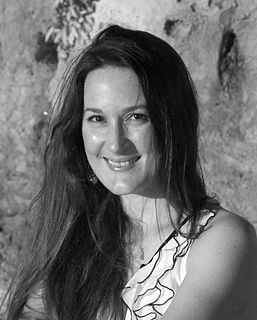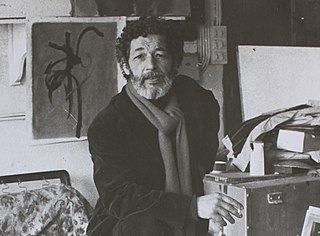Related Research Articles

Juan Soriano was a Mexican artist known for his paintings, sculptures and theater work. He was a child prodigy whose career began early as did his fame with various writers authoring works about him. He exhibited in the United States and Europe as well as major venues in Mexico such as the Museo de Arte Moderno and the Palacio de Bellas Artes. His monumental sculptures can be found in various parts of Mexico and in Europe as well. Recognitions of his work include Mexico's National Art Prize, the Chevalier des Arts et Lettres and membership in France's Legion of Honour.

Raúl Soldi was an Argentine painter whose work treated various subjects, including landscapes, portraits, the theater and the circus, and nature. His theatrical figures are renowned for their melancholy appearance. He also illustrated poetry books.
Victor Grippo was an Argentine painter, engraver and sculptor, considered the father of conceptual art in Argentina. He was born in Junín, province of Buenos Aires, the elder of two sons of an Italian immigrant father and an Argentine mother of Albanese origin.

Emilio Pettoruti (1892–1971) was an Argentine painter, who caused a scandal with his avant-garde cubist exhibition in 1924 in Buenos Aires. At the beginning of the twentieth century, Buenos Aires was a city full of artistic development. Pettoruti's career was thriving during the 1920s when "Argentina witnessed a decade of dynamic artistic activity; it was an era of euphoria, a time when the definition of modernity was developed." While Pettoruti was influenced by Cubism, Futurism, Constructivism, and Abstraction, he did not claim to paint in any of those styles in particular. Exhibiting all over Europe and Argentina, Emilio Pettoruti is remembered as one of the most influential artists in Argentina in the 20th century for his unique style and vision.

Gyula Kosice was a Czechoslovakian-born Argentine sculptor, plastic artist, and poet. He was one of the most important figures in kinetic and luminal art and luminance vanguard.
Luis Felipe Noé is an Argentine artist, writer, intellectual and teacher. He is known in his home country as Yuyo. In 1961 he formed Otra Figuración with three other Argentine artists. Their eponymous exhibition and subsequent work greatly influenced the Neofiguration movement. After the group disbanded, Noé relocated to New York City where he painted and showed assemblages that stretched the boundaries of the canvas.
Alfredo Prior is a painter, writer, performer and musician. His career began at the age of 18 with his first solo exhibition in Buenos Aires, where he still lives and works.

Alejandro Colunga Marín is a Mexican artist, painter and sculptor.

Celis Pérez was an Argentine artist usually referred to as Pérez Celis. He earned international recognition for his paintings, sculptures, murals and engravings.

Nicolás García Uriburu was an Argentine contemporary artist, landscape architect, and ecologist. His work in land art was aimed at raising consciousness about environmental issues such as water pollution.
Paul Fontaine (1913–1996) was an American painter.

Manuel Zorrilla de la Torre was an Argentinian painter, illustrator, engraver, drawer, and sculptor. His parents were Spanish immigrants.

Carlos Alonso, is a contemporary Argentine painter, draftsman and printmaker. Though he was a Social realist in his early career, he is best known as a New realist. Beef is a common element in his work.
Alfredo Da Silva was a painter, graphic artist, and photographer, known for his abstract expressionism. He came to international prominence in 1959 and remained so until his death in 2020.
Javier Arevalo was a contemporary Mexican artist whose work was the subject of many exhibitions, worldwide, including in Europe, Latin America, United States, Mexico and Japan. His influence was greatest in Mexico City, and Guadalajara, Jalisco. He also taught Art at the Palacio de Bellas Artes in Mexico City.

Cecilia Lueza is an Argentine-born American painter and sculptor.
Wolfgang H. Scholz is a German painter, photographer and film director. He lives and works in Mexico City and Munich.
Luis Valsoto is a Mexican artist strongly associated with the state of Jalisco, which has honored his work multiple times. He is noted for his depictions of ordinary life and everyday things, especially domestic animals such as dogs, cats and horses. He has exhibited his work individually in various venues in Mexico and the United States and collectively both in Mexico and several other countries.

Jorge Brito (1925–1996) was a painter, sculptor and muralist. He is famous for having signed the Manifesto of four young artists distributed at the opening of the National Art Exhibition of Buenos Aires, in which four art students opposed the institution and identified their opponents as the "stonecutters". In the pamphlet, they questioned the orientation sought to be imposed on art education, by both mediocre winners and the "vanguard" jurors who rewarded them. The manifesto was signed by Jorge Brito, Claudio Girola, Tomas Maldonado and Alfredo Hlito who, in 1942, were students of the National School of Fine Arts Prilidiano Pueyrredón.
Diego Bianchi is an Argentinian visual artist. He lives and works in Buenos Aires, Argentina.